This post is a follow-on to the previous one, in which I covered the Friday of Nine Worlds 2015. Saturday continued along similar lines, with sketchnotes along the way.
9am – Imagining The Future – When The Future is Already Now
I wasn’t startlingly awake for this 9am panel – so the notes are a little sparse. I’ve sort of vaguely met @andypiper a couple of times at various tech cons (at least at barcamp events) so I had a rough idea that he’d be able to deliver a good overview of what’s cool in the emerging tech world.
Whilst a fair bit of the stuff covered wasn’t new to me, it was pretty new and an interesting panel.
Due to my background, I’m particularly interested in the AI / Deep Learning area, but the whole lot was pretty cool.
What I’m really waiting for in the future of tech, though, is for the democratization of current bleeding edge tech. I want to start seeing ownership of stuff like 3D printing and weird materials like Graphene move away from the tech elite and into the hands of everyday people. That’s when we’ll start seeing the big changes – once hi-tech tools start getting into the hands of the masses is when the world changes.
3D printing, in particular, is so close to being there.
10am – Show, Don’t Tell – Wordless Comics – Why Make Wordless Comics? What Do They Represent
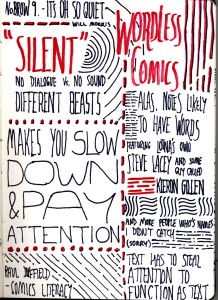
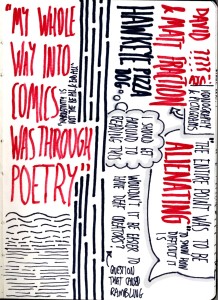
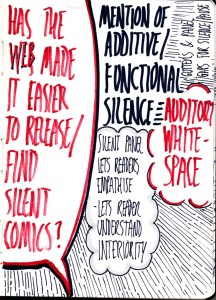
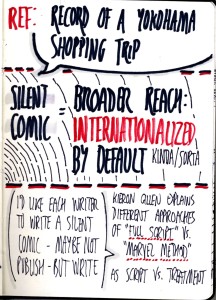
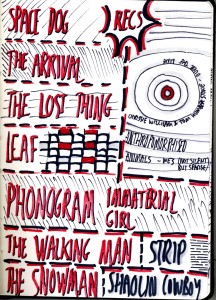 I’m note really sure what I can add to a discussion of this panel that the sketchnotes don’t really cover. First up, a friend of mine was on the panel – Steve Lacey, who’s a regular at LOTNA and also the host of the Fantasticast.
I’m note really sure what I can add to a discussion of this panel that the sketchnotes don’t really cover. First up, a friend of mine was on the panel – Steve Lacey, who’s a regular at LOTNA and also the host of the Fantasticast.
The panel was essentially a love-in around the theme of silent or wordless comics. A reasonable amount of time was dedicated to the difference between those two descriptions:
Silent and Wordless – not all wordless things are silent, as not all noises are words.
The topic of silence and silent panels being there for a reason came up – how they’re used to indicate interior thought processes and unexpressed emotion, and how that in turn generates empathy with the characters.
As somebody who works in a design field, I’m well aware of the concept of functional, active or additive white-space. The idea of graphically presented silence is remarkably similar – the use of emptiness to serve a function, rather than just being a spot where the artist forgot to draw.
The main thing for me to take away from this panel is that I should really, REALLY get hold of the David Aja & Matt Fraction Hawkeye stuff (this panel could easily have been subtitled “Pizza Dog and some other stuff”).
Other recommendations (in case you can’t read my poorly scribbled recommendations notes above):
- Space Dog
- The Arrival
- The Lost Thing
- Leaf
- Phonogram – Immaterial Girl (not out yet?)
- The Walking Man
- Strip (comic NSFW)
- Shaolin Cowboy
- The Snowman (which, in case folks forget, was a silent comic / picture book before it was a film)
11:45am – We Are Not Things: Wives, Imperators and Blood Bags in Mad Max: Fury Road
This was a crowded, crowded panel. It really, really needed to be in a bigger room, but as it was, I was very glad to get it for it.
The first things I have to mention is that there was an amazing Furiosa cosplayer in the room. If she hadn’t fitted into the room, and I’d noticed, I’d have given up my seat to get her in – I’d have missed an excellent panel, but if she’d not been in the room it would have been criminal.
Once again, there’s not much I can really add beyond the notes, but one thing to clarify – whilst the notes pick up on the comments around it still being a very white film… there was a fair bit said (not just in this panel) about how something can have problematic aspects and still be bloody good. About which, huzzah!
Quick notes on other things that the panel picked up on:
- The many mothers were awesome, and a great depiction of older women with character, agency and capability.
- The Warboys didn’t exactly have a great time either – they suffered under Immortan Joe and his cronies too. They were basically ammunition rather than people.
- Furiosa’s physical disability (her missing hand) never even remotely impairs her capability
- The film is really good at portraying allies (in the feminist / LGBTQ+ sense of the word).
1:30pm – Three Talks on Gaming Environments
This was a session in the academic track (as several previously discussed sessions have been), so the presentation was a little different.
The first of these talks was an exploration into determining three key attributes of board games, than then graphing how those attributes vary over the course of play.
Those graphs could then be used to quickly visualise how games played, and to identify common patterns in games you enjoyed. I’d be intrigued to start seeing more examples of this, and may well track down the speaker’s details to find more on the web.
The second talk was the one I was particularly present for – it was an interesting panel, even if I disagreed with some bits here and there.
In particular, it had a very narrow, prescriptive definitions of “design” and a lot of attributing causes of failure to things that didn’t appear (from the presentation) to have been the main problem. I suspect a lot of that comes down to choice of terminology and semantics, though – and once disagreement gets to semantics, you’re not going to get past them in a short presentation.
I’m not going to say much more on the downside, other than that I liked the the general idea of what had been attempted (and reported on here), but didn’t entirely agree with the assumptions behind the conclusions. I’m not going to say they were wrong – because I strongly suspect they aren’t wrong, but I question how firmly backed by the experimentation.
On the upside, the speaker was discussing an attempt to use LARP-like behaviour to help people learn to deal with situations and pressures. It may not have worked out for the participants, but the attempt was an interesting one.
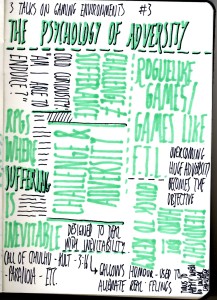 The final session was on the psychology of adversity – and it was a fairly challenging panel, so oddly fitting. The focus was on how challenge is typically a good thing in certain ways, but that it changes from being challenge to suffering and inevitability once apathy takes over.
The final session was on the psychology of adversity – and it was a fairly challenging panel, so oddly fitting. The focus was on how challenge is typically a good thing in certain ways, but that it changes from being challenge to suffering and inevitability once apathy takes over.
If you can no longer be bothered to resist adversity, then it ceases to be a challenge and becomes suffering.
The session discussed how being able to affect a situation keeps it from turning to apathy, whilst being unable to do so leads it towards apathy and hence from challenge to suffering.
Interesting slot, but I think it needed longer for me to really get it.
8:30pm – Gaming Across the Streams – LARP, RPG, Social, Tabletop – What’s the Difference?
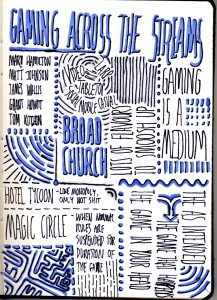
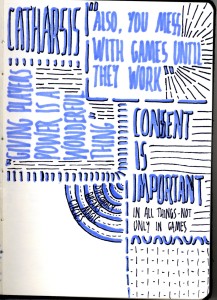 This was one of those amazingly, gloriously rambling panels, aided in its glorious rambly-ness by the fact that two of the speakers had only just got off the plane from the states, and were basically fried!
This was one of those amazingly, gloriously rambling panels, aided in its glorious rambly-ness by the fact that two of the speakers had only just got off the plane from the states, and were basically fried!
But it still managed to be a highly entertaining and interesting panel. As a LARPer, TT-RPGer, point-and-click PC gamer, a board gamer and a few other things involving games as well… I was interested.
Because it was so rambly, I can’t really isolate a common theme beyond “games are cool” and “gaming tastes go great together”… but it was a cool panel.
Particular bits that resonated (because they’re things I espouse in my gaming ramblings as well) were the ideas that consent is important – not just about anything kinky or weird, but about buying in to games worlds, accepting mechanics, investing in themes and all of that. If the players don’t give active consent to the game… it’s not a game.
So, whilst the difference was still left largely undiscussed, the similarities were talked about at length.
After this, there was food, and there was a bar until the small hours with LOTNA people. These were good things. After those good things, there was sleep.
If you want to know more about the con in general, go to the Nine Worlds website.
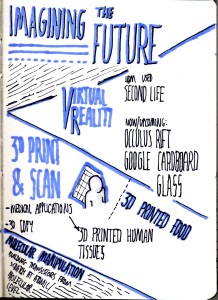
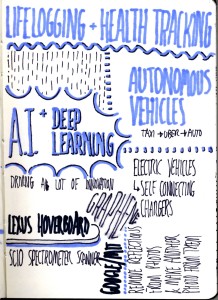
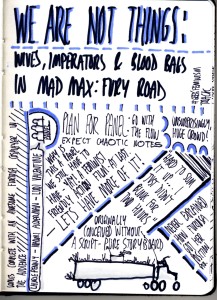
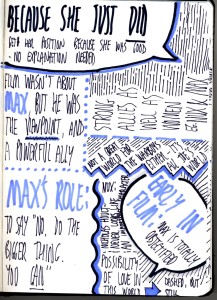
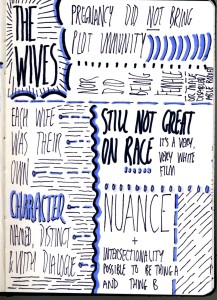
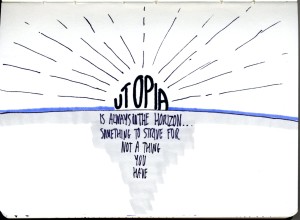
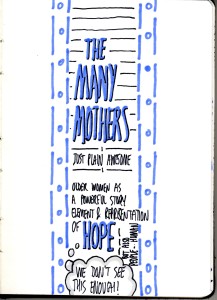
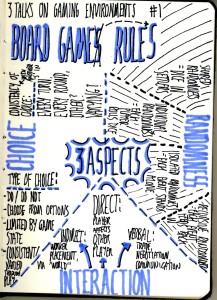
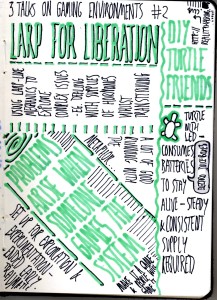
Leave a Reply